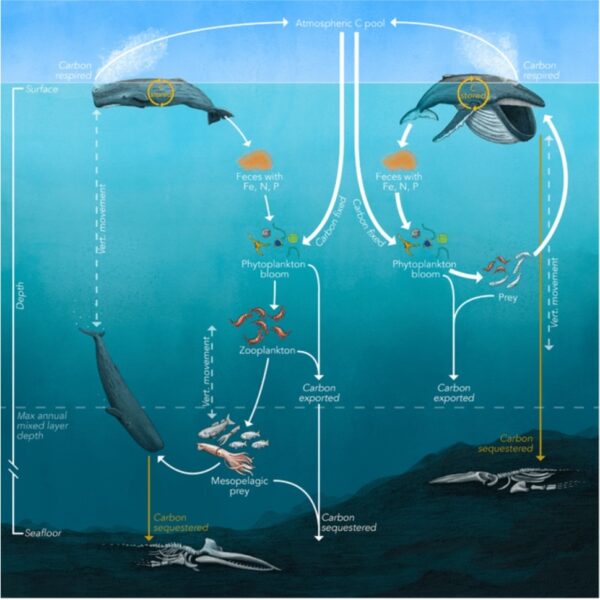While many efforts to fight climate change have focused on planting trees or restoring wetlands, researchers publishing in Trends in Ecology and Evolution advocate for the importance of understanding the carbon sequestration potential of the planet’s largest animals—whales.
In their paper, the researchers explore how whales can influence the amount of carbon in our air and waters and potentially contribute to the overall reduction of atmospheric carbon dioxide.
However, the authors warn that there is a lot of work needed to get to the level of verifiability needed for carbon credits for whales.
“Understanding the role of whales in the carbon cycle is a dynamic and emerging field that may benefit both marine conservation and climate-change strategies,” write the authors.
Image: Whales’ direct and indirect nutrient and carbon cycling pathways. Credit: Trends in Ecology & Evolution/Pearson
Whale carbon credits
Whales can weigh up to 150 tons, live more than 100 years and their biomass is composed largely of carbon. They make up one of the largest living carbon pools in the pelagic ocean, part of the marine system that is responsible for storing 22% of Earth’s total carbon.
This carbon absorbing feature has created interest from the International Monetary Fund in creating whale carbon credits or other financial mechanisms that could finance the fight against climate change and biodiversity loss. However, in Bloomberg the scientists behind the carbon research deliver a message: Don’t monetize the whales.
“Recent attempts to monetize whales have garnered attention by valuing an ‘average’ whale at $2 million for carbon-capture and other services,” the scientists wrote in the peer-reviewed study. “As the authors of several foundational papers cited in these reports, we feel the scientific support for this valuation is lacking.”
“Whales have many ecosystem values, carbon removal potentially being one of them,” Heidi Pearson, lead author, said. “But the state of the science is still in its infancy and not ready to make that leap from whale carbon to climate change policy, and even further afield, talking about carbon credits, which is leaps and bounds down the road.”
Whale recovery can enhance the ocean carbon sink
“Their size and longevity allow whales to exert strong effects on the carbon cycle by storing carbon more effectively than small animals,” write the authors.
When they finish digesting their food, their excrement is rich in important nutrients that help these krill and plankton flourish, aiding in increased photosynthesis and carbon storage from the atmosphere.
A blue whale can live up to 90 years. When they die and their bodies fall to the seafloor, the carbon they contain is transferred to the deep sea as they decay. This supplements the biological carbon pump, where nutrients and chemicals are exchanged between the ocean and the atmosphere through complex biogeochemical pathways. Commercial hunting, the largest source of population decline, has decreased whale populations by 81%, with unknown effects on biological carbon pump.
“Whale recovery has the potential for long-term self-sustained enhancement of the ocean carbon sink,” the authors write. “The full carbon dioxide reduction role of great whales (and other organisms) will only be realized through robust conservation and management interventions that directly promote population increases.”
Further information:
The press release from the authors of the study can be read here.
Stories can be found in CNN, Bloomberg and Washington Post.
The peer reviewed study in Trends in Ecology and Evolution can be found here.
